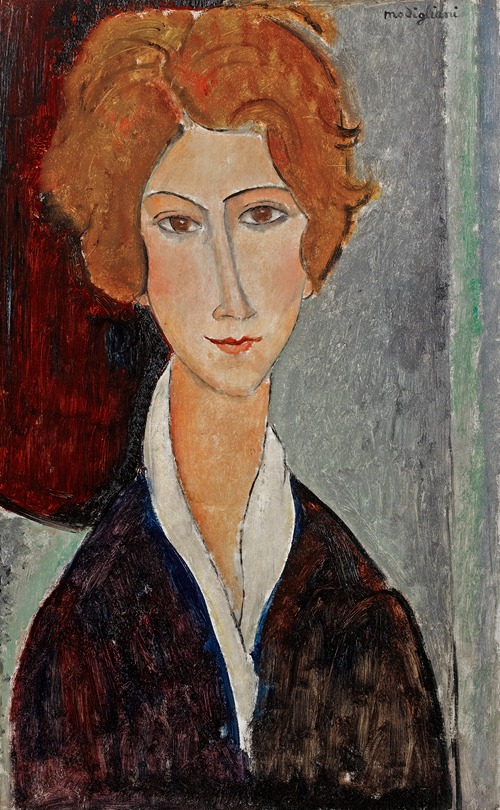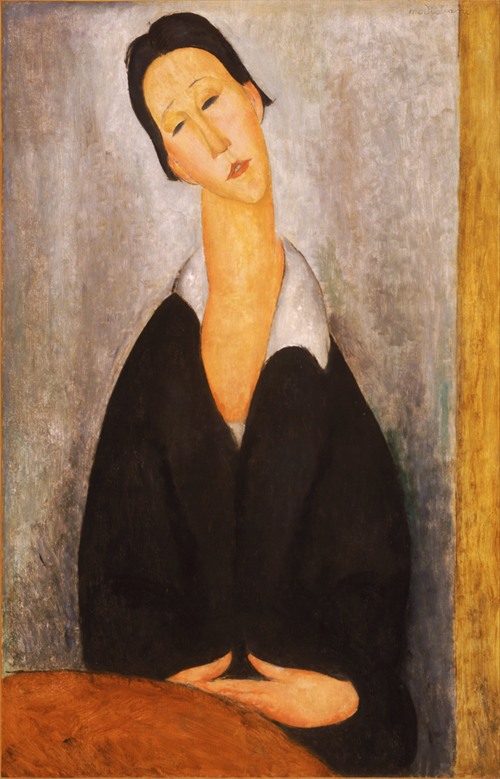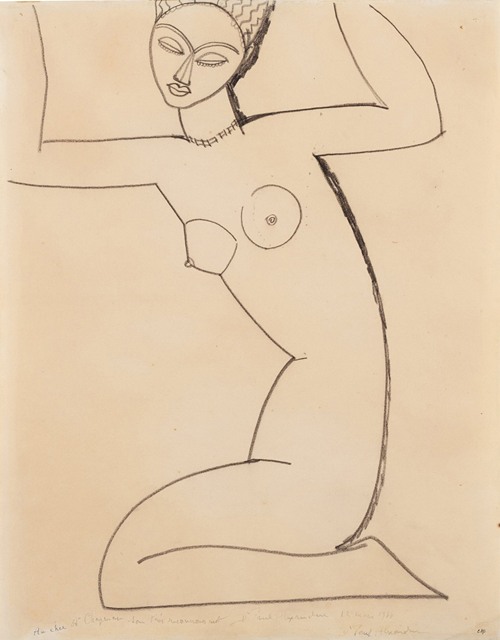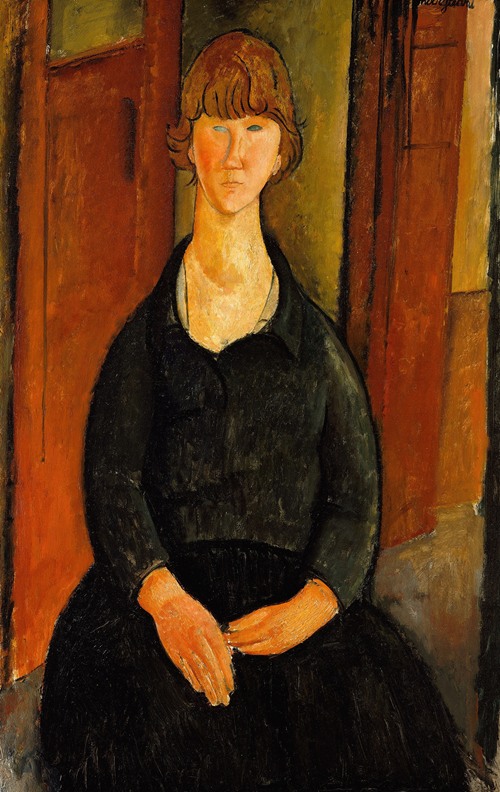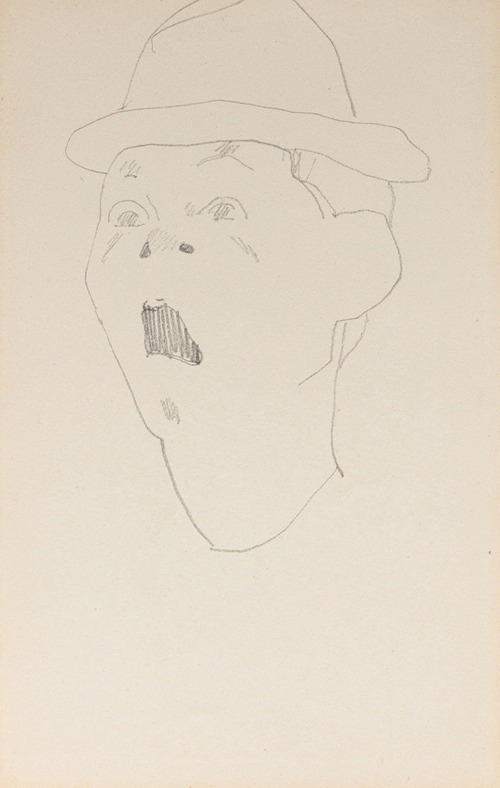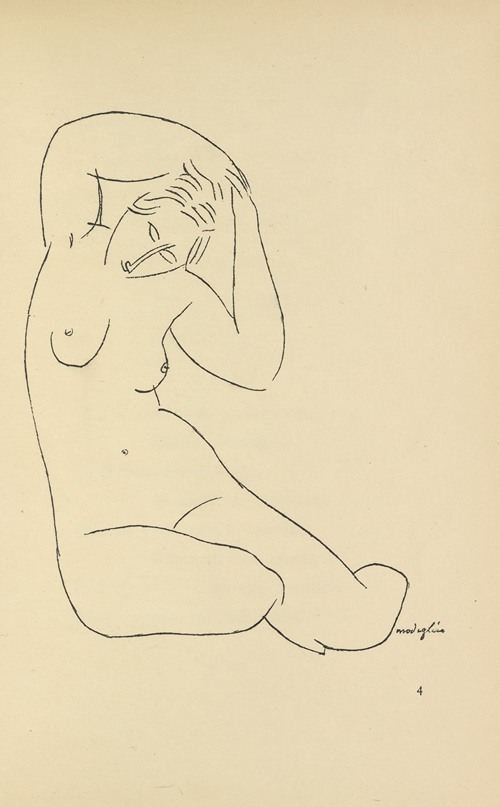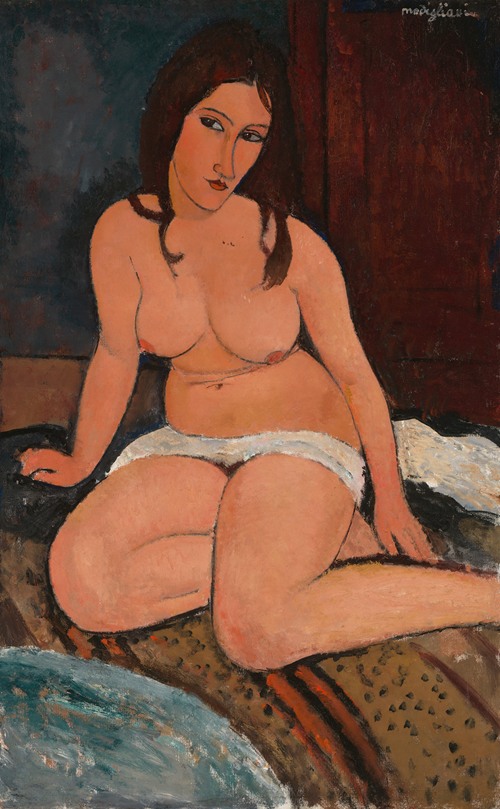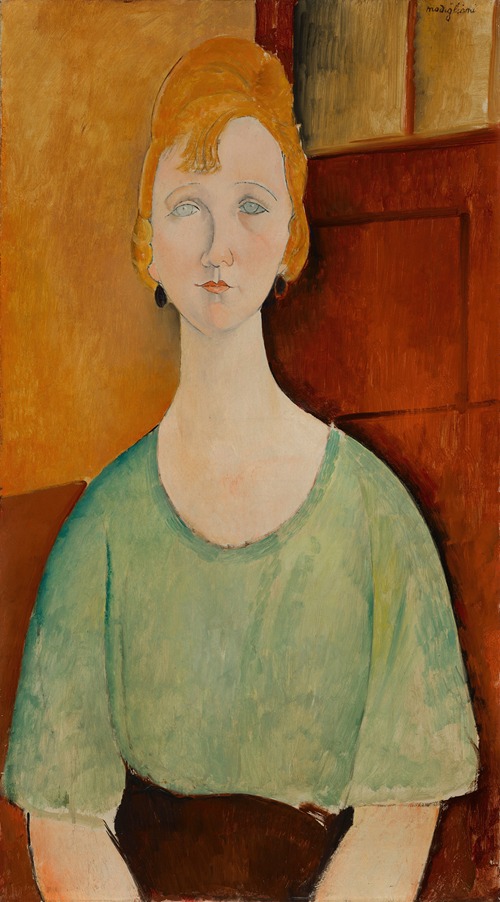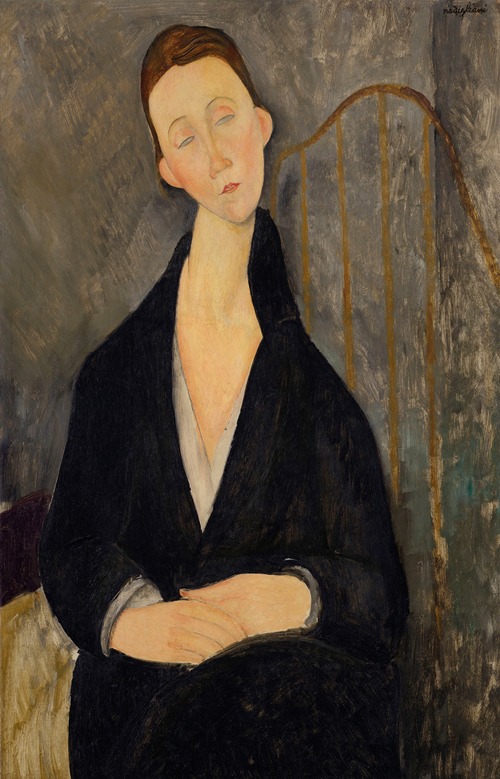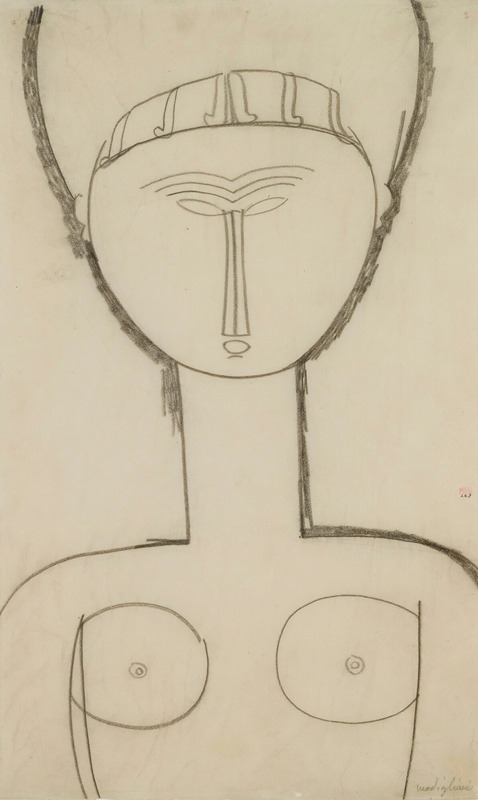
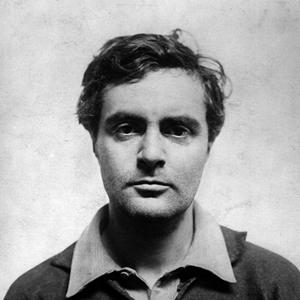
Amedeo Clemente Modigliani was an Italian painter and sculptor who worked mainly in France. He is known for portraits and nudes in a modern style characterized by a surreal elongation of faces, necks, and figures that were not received well during his lifetime, but later became much sought-after. Modigliani spent his youth in Italy, where he studied the art of antiquity and the Renaissance. In 1906, he moved to Paris, where he came into contact with such artists as Pablo Picasso and Constantin Brâncuși. By 1912 Modigliani was exhibiting highly stylized sculptures with Cubists of the Section d'Or group at the Salon d'Automne.
Modigliani's oeuvre includes paintings and drawings. From 1909 to 1914, he devoted himself mainly to sculpture. His main subject was portraits and full figures, both in the images and in the sculptures. Modigliani had little success while alive, but after his death achieved great popularity. He died of tubercular meningitis, at the age of 35, in Paris.
Modigliani was born into a Sephardic Jewish family in Livorno, Italy. A port city, Livorno had long served as a refuge for those persecuted for their religion, and was home to a large Jewish community. His maternal great-great-grandfather, Solomon Garsin, had immigrated to Livorno in the 18th century as a refugee.
Modigliani's mother, Eugénie Garsin, born and raised in Marseille, was descended from an intellectual, scholarly family of Sephardic ancestry that for generations had lived along the Mediterranean coastline. Fluent in many languages, her ancestors were authorities on sacred Jewish texts and had founded a school of Talmudic studies. Family legend traced the family lineage to the 17th-century Dutch philosopher Baruch Spinoza. The family business was money lending, with branches in Livorno, Marseille, Tunis, and London, though their fortunes ebbed and flowed.
Modigliani's father, Flaminio, was a member of an Italian Jewish family of successful businessmen and entrepreneurs. While not as culturally sophisticated as the Garsins, they knew how to invest in and develop thriving business endeavors. When the Garsin and Modigliani families announced the engagement of their children, Flaminio was a wealthy young mining engineer. He managed the mine in Sardinia and also managed the almost 30,000 acres (12,141 ha) of timberland the family owned.
A reversal in fortune occurred to this prosperous family in 1883. An economic downturn in the price of metal plunged the Modiglianis into bankruptcy. Ever resourceful, Modigliani's mother used her social contacts to establish a school and, along with her two sisters, made the school into a successful enterprise.
Amedeo Modigliani was the fourth child, whose birth coincided with the disastrous financial collapse of his father's business interests. Amedeo's birth saved the family from ruin; according to an ancient law, creditors could not seize the bed of a pregnant woman or a mother with a newborn child. The bailiffs entered the family's home just as Eugénie went into labour; the family protected their most valuable assets by piling them on top of her.
Modigliani had a close relationship with his mother, who taught him at home until he was 10. Beset with health problems after an attack of pleurisy when he was about 11, a few years later he developed a case of typhoid fever. When he was 16 he was taken ill again and contracted the tuberculosis which would later claim his life. After Modigliani recovered from the second bout of pleurisy, his mother took him on a tour of southern Italy: Naples, Capri, Rome and Amalfi, then north to Florence and Venice.
His mother was, in many ways, instrumental in his ability to pursue art as a vocation. When he was 11 years of age, she had noted in her diary: "The child's character is still so unformed that I cannot say what I think of it. He behaves like a spoiled child, but he does not lack intelligence. We shall have to wait and see what is inside this chrysalis. Perhaps an artist?"
Modigliani is known to have drawn and painted from a very early age, and thought himself "already a painter", his mother wrote, even before beginning formal studies. Despite her misgivings that launching him on a course of studying art would impinge upon his other studies, his mother indulged the young Modigliani's passion for the subject.
At the age of fourteen, while sick with typhoid fever, he raved in his delirium that he wanted, above all else, to see the paintings in the Palazzo Pitti and the Uffizi in Florence. As Livorno's local museum housed only a sparse few paintings by the Italian Renaissance masters, the tales he had heard about the great works held in Florence intrigued him, and it was a source of considerable despair to him, in his sickened state, that he might never get the chance to view them in person. His mother promised that she would take him to Florence herself, the moment he was recovered. Not only did she fulfil this promise, but she also undertook to enroll him with the best painting master in Livorno, Guglielmo Micheli.
Modigliani worked in Micheli's Art School from 1898 to 1900. Among his colleagues in that studio would have been Llewelyn Lloyd, Giulio Cesare Vinzio, Manlio Martinelli, Gino Romiti, Renato Natali, and Oscar Ghiglia. Here his earliest formal artistic instruction took place in an atmosphere steeped in a study of the styles and themes of 19th-century Italian art. In his earliest Parisian work, traces of this influence, and that of his studies of Renaissance art, can still be seen. His nascent work was influenced by such Parisian artists as Giovanni Boldini and Toulouse-Lautrec.
Modigliani showed great promise while with Micheli, and ceased his studies only when he was forced to, by the onset of tuberculosis.
In 1901, whilst in Rome, Modigliani admired the work of Domenico Morelli, a painter of dramatic religious and literary scenes. Morelli had served as an inspiration for a group of iconoclasts who were known by the title "the Macchiaioli" (from macchia —"dash of colour", or, more derogatively, "stain"), and Modigliani had already been exposed to the influences of the Macchiaioli. This localized landscape movement reacted against the bourgeois stylings of the academic genre painters. While sympathetically connected to (and actually pre-dating) the French Impressionists, the Macchiaioli did not make the same impact upon international art culture as did the contemporaries and followers of Monet, and are today largely forgotten outside Italy.
Modigliani's connection with the movement was through Guglielmo Micheli, his first art teacher. Micheli was not only a Macchiaiolo himself, but had been a pupil of the famous Giovanni Fattori, a founder of the movement. Micheli's work, however, was so fashionable and the genre so commonplace that the young Modigliani reacted against it, preferring to ignore the obsession with landscape that, as with French Impressionism, characterized the movement. Micheli also tried to encourage his pupils to paint en plein air, but Modigliani never really got a taste for this style of working, sketching in cafés, but preferring to paint indoors, and especially in his own studio. Even when compelled to paint landscapes (three are known to exist), Modigliani chose a proto-Cubist palette more akin to Cézanne than to the Macchiaioli.
While with Micheli, Modigliani studied not only landscape, but also portraiture, still life, and the nude. His fellow students recall that the last was where he displayed his greatest talent, and apparently this was not an entirely academic pursuit for the teenager: when not painting nudes, he was occupied with seducing the household maid.
Despite his rejection of the Macchiaioli approach, Modigliani nonetheless found favour with his teacher, who referred to him as "Superman", a pet name reflecting the fact that Modigliani was not only quite adept at his art, but also that he regularly quoted from Nietzsche's Thus Spoke Zarathustra. Fattori himself would often visit the studio, and approved of the young artist's innovations.
In 1902, Modigliani continued what was to be a lifelong infatuation with life drawing, enrolling in the Scuola Libera di Nudo, or "Free School of Nude Studies", of the Accademia di Belle Arti in Florence. A year later, while still suffering from tuberculosis, he moved to Venice, where he registered to study at the Regia Accademia ed Istituto di Belle Arti. It is in Venice that he first smoked hashish and, rather than studying, began to spend time frequenting disreputable parts of the city. The impact of these lifestyle choices upon his developing artistic style is open to conjecture, although these choices do seem to be more than simple teenage rebellion, or the clichéd hedonism and bohemianism that was almost expected of artists of the time; his pursuit of the seedier side of life appears to have roots in his appreciation of radical philosophies, including those of Nietzsche.
Having been exposed to erudite philosophical literature as a young boy under the tutelage of Isaco Garsin, his maternal grandfather, he continued to read and be influenced through his art studies by the writings of Nietzsche, Baudelaire, Carducci, Comte de Lautréamont, and others, and developed the belief that the only route to true creativity was through defiance and disorder.
The work of Lautréamont was equally influential at this time. This doomed poet's Les Chants de Maldoror became the seminal work for the Parisian Surrealists of Modigliani's generation, and the book became Modigliani's favourite to the extent that he learnt it by heart. The poetry of Lautréamont is characterized by the juxtaposition of fantastical elements, and by sadistic imagery; the fact that Modigliani was so taken by this text in his early teens gives a good indication of his developing tastes. Baudelaire and D'Annunzio similarly appealed to the young artist, with their interest in corrupted beauty, and the expression of that insight through Symbolist imagery.
In 1906, Modigliani moved to Paris, then the focal point of the avant-garde. In fact, his arrival at the centre of artistic experimentation coincided with the arrival of two other foreigners who were also to leave their marks upon the art world: Gino Severini and Juan Gris.
He later befriended Jacob Epstein, they aimed to set up a studio together with a shared vision to create a Temple of Beauty to be enjoyed by all, for which Modigliani created drawings and paintings of the intended stone caryatids for ‘The Pillars of Tenderness’ which would support the imagined temple.
Modigliani squatted in the Bateau-Lavoir, a commune for penniless artists in Montmartre, renting himself a studio in Rue Caulaincourt. Even though this artists' quarter of Montmartre was characterized by generalized poverty, Modigliani himself presented—initially, at least—as one would expect the son of a family trying to maintain the appearances of its lost financial standing to present: his wardrobe was dapper without ostentation, and the studio he rented was appointed in a style appropriate to someone with a finely attuned taste in plush drapery and Renaissance reproductions. He soon made efforts to assume the guise of the bohemian artist, but, even in his brown corduroys, scarlet scarf and large black hat, he continued to appear as if he were slumming it, having fallen upon harder times.
When he first arrived in Paris, he wrote home regularly to his mother, he sketched his nudes at the Académie Colarossi, and he drank wine in moderation. He was at that time considered by those who knew him as a bit reserved, verging on the asocial. He is noted to have commented, upon meeting Picasso who, at the time, was wearing his trademark workmen's clothes, that even though the man was a genius, that did not excuse his uncouth appearance.
Within a year of arriving in Paris, however, his demeanour and reputation had changed dramatically. He transformed himself from a dapper academician artist into a sort of prince of vagabonds.
The poet and journalist Louis Latourette, upon visiting the artist's previously well-appointed studio after his transformation, discovered the place in upheaval, the Renaissance reproductions discarded from the walls, the plush drapes in disarray. Modigliani was already an alcoholic and a drug addict by this time, and his studio reflected this. Modigliani's behaviour at this time sheds some light upon his developing style as an artist, in that the studio had become almost a sacrificial effigy for all that he resented about the academic art that had marked his life and his training up to that point.
Not only did he remove all the trappings of his bourgeois heritage from his studio, but he also set about destroying practically all of his own early work, which he described as "Childish baubles, done when I was a dirty bourgeois".
The motivation for this violent rejection of his earlier self is the subject of considerable speculation. From the time of his arrival in Paris, Modigliani consciously crafted a charade persona for himself and cultivated his reputation as a hopeless drunk and voracious drug user. His escalating intake of drugs and alcohol may have been a means by which Modigliani masked his tuberculosis from his acquaintances, few of whom knew of his condition. Tuberculosis—the leading cause of death in France by 1900—was highly communicable, there was no cure, and those who had it were feared, ostracized, and pitied. Modigliani thrived on camaraderie and would not let himself be isolated as an invalid; he used drink and drugs as palliatives to ease his physical pain, helping him to maintain a façade of vitality and allowing him to continue to create his art.
Modigliani's use of drink and drugs intensified from about 1914 onward. After years of remission and recurrence, this was the period during which the symptoms of his tuberculosis worsened, signaling that the disease had reached an advanced stage.
He sought the company of artists such as Utrillo and Soutine, seeking acceptance and validation for his work from his colleagues. Modigliani's behavior stood out even in these Bohemian surroundings: he carried on frequent affairs, drank heavily, and used absinthe and hashish. While drunk, he would sometimes strip himself naked at social gatherings. He died in Paris, aged 35. He became the epitome of the tragic artist, creating a posthumous legend almost as well known as that of Vincent van Gogh.
During the 1920s, in the wake of Modigliani's career and spurred on by comments by André Salmon crediting hashish and absinthe with the genesis of Modigliani's style, many hopefuls tried to emulate his "success" by embarking on a path of substance abuse and bohemian excess. Salmon claimed that whereas Modigliani was a totally pedestrian artist when sober, "...from the day that he abandoned himself to certain forms of debauchery, an unexpected light came upon him, transforming his art. From that day on, he became one who must be counted among the masters of living art."
Some art historians suggest that it is entirely possible that Modigliani would have achieved even greater artistic heights had he not been immured in, and destroyed by, his own self-indulgences.
During his early years in Paris, Modigliani worked at a furious pace. He was constantly sketching, making as many as a hundred drawings a day. However, many of his works were lost—destroyed by him as inferior, left behind in his frequent changes of address, or given to girlfriends who did not keep them.
He was first influenced by Henri de Toulouse-Lautrec, but around 1907 he became fascinated with the work of Paul Cézanne. Eventually he developed his own unique style, one that cannot be adequately categorized with those of other artists.
He met the first serious love of his life, Russian poet Anna Akhmatova, in 1910, when he was 26. They had studios in the same building, and although 21-year-old Anna had recently married, they began an affair. Anna was tall with dark hair, pale skin and grey-green eyes: she embodied Modigliani's aesthetic ideal and the pair became engrossed in each other. After a year, however, Anna returned to her husband.
In 1909, Modigliani returned home to Livorno, sickly and tired from his wild lifestyle. Soon he was back in Paris, this time renting a studio in Montparnasse. He originally saw himself as a sculptor rather than a painter, and was encouraged to continue after Paul Guillaume, an ambitious young art dealer, took an interest in his work and introduced him to sculptor Constantin Brâncuși. He was Constantin Brâncuși's disciple for one year.
Although a series of Modigliani's sculptures were exhibited in the Salon d'Automne of 1912, by 1914 he abandoned sculpting and focused solely on his painting, a move precipitated by the difficulty in acquiring sculptural materials due to the outbreak of war, and by Modigliani's physical debilitation.
In June 2010 Modigliani's Tête, a limestone carving of a woman's head, became the third most expensive sculpture ever sold.
Modigliani painted a series of portraits of contemporary artists and friends in Montparnasse: Chaïm Soutine, Moïse Kisling, Pablo Picasso, Diego Rivera, Marie "Marevna" Vorobyev-Stebeslka, Juan Gris, Max Jacob, Jacques Lipchitz, Blaise Cendrars, and Jean Cocteau, all sat for stylized renditions.
At the outset of World War I, Modigliani tried to enlist in the army but was refused because of his poor health.
Known as Modì (which plays on the French word 'maudit', meaning 'cursed') by many Parisians, but as Dedo to his family and friends, Modigliani was a handsome man, and attracted much female attention. Women came and went until Beatrice Hastings entered his life. She stayed with him for almost two years, was the subject of several of his portraits, including Madame Pompadour, and the object of much of his drunken wrath.
When the British painter Nina Hamnett arrived in Montparnasse in 1914, on her first evening there the smiling man at the next table in the café introduced himself as "Modigliani, painter and Jew". They became great friends.
In 1916, Modigliani befriended the Polish poet and art dealer Léopold Zborowski and his wife Anna. Zborowski became Modigliani's primary art dealer and friend during the artist's final years, helping him financially, and also organizing his show in Paris in 1917.
The several dozen nudes Modigliani painted between 1916 and 1919 constitute many of his best-known works. This series of nudes was commissioned by Modigliani's dealer and friend Léopold Zborowski, who lent the artist use of his apartment, supplied models and painting materials, and paid him between fifteen and twenty francs each day for his work.
The paintings from this arrangement were thus different from his previous depictions of friends and lovers in that they were funded by Zborowski either for his own collection, as a favor to his friend, or with an eye to their "commercial potential", rather than originating from the artist's personal circle of acquaintances.
The Paris show of 1917 was Modigliani's only solo exhibition during his life, and is "notorious" in modern art history for its sensational public reception and the attendant issues of obscenity. The show was closed by police on its opening day, but continued thereafter, most likely after the removal of paintings from the gallery's streetfront window.
On a trip to Nice which had been conceived and organized by Zborowski, Modigliani, Foujita and other artists tried to sell their works to rich tourists. Modigliani managed to sell a few pictures, but only for a few francs each. Despite this, during this time he produced most of the paintings that later became his most popular and valued works.
During his lifetime, he sold a number of his works, but never for any great amount of money. What funds he did receive soon vanished for his habits.
In the spring of 1917, the Russian sculptor Chana Orloff introduced him to a 19-year-old art student named Jeanne Hébuterne who had posed for Tsuguharu Foujita. From a conservative bourgeois background, Hébuterne was renounced by her devout Roman Catholic family for her liaison with Modigliani, whom they saw as little more than a debauched derelict. Despite her family's objections, soon they were living together.
Modigliani ended his relationship with the English poet and art critic Beatrice Hastings and a short time later Hébuterne and Modigliani moved together into a studio on the Rue de la Grande Chaumière. Jeanne began to pose for him and appears in several of his paintings. Jeanne Hébuterne became a principal subject for Modigliani's art.
Towards the end of the First World War, early in 1918, Modigliani left Paris with Hébuterne to escape from the war and travelled to Nice and Cagnes-sur-Mer. They would spend a year in France. During that time they had a busy social life with many friends, including Pierre-Auguste Renoir, Pablo Picasso, Giorgio de Chirico and André Derain.
After he and Hébuterne moved to Nice on 29 November 1918, she gave birth to a daughter whom they named Jeanne (1918–1984). Modigliani already had a son from his relationship with Simone Thiroux, Gérard Thiroux (1917–2004), and at least two other illegitimate children. In May 1919 they returned to Paris with their infant daughter and moved into an apartment on the rue de la Grande Chaumière.
Hébuterne became pregnant again. Modigliani then got engaged to her, but Jeanne's parents were against the marriage, especially because of Modigliani's reputation as an alcoholic and drug user. However, Modigliani officially recognized her daughter as his child. The wedding plans were shattered independently of Jeanne's parents' resistance when Modigliani discovered he had a severe form of tuberculosis.
Although he continued to paint, Modigliani's health deteriorated rapidly, and his alcohol-induced blackouts became more frequent.
In 1920, after not hearing from him for several days, a neighbour checked on the family and found Modigliani in bed delirious and holding onto Hébuterne. A doctor was summoned, but little could be done because Modigliani was in the final stage of his disease, tubercular meningitis. He died on 24 January 1920, at the Hôpital de la Charité.
There was an enormous funeral, attended by many from the artistic communities in Montmartre and Montparnasse. When Modigliani died, twenty-one-year-old Hébuterne was eight months pregnant with their second child.
A day later, Hébuterne was taken to her parents' home. There, inconsolable, she threw herself out of a fifth-floor window, the day after Modigliani's death, killing herself and her unborn child. Modigliani was buried in Père Lachaise Cemetery. Hébuterne was buried at the Cimetière de Bagneux near Paris, and it was not until 1930 that her embittered family allowed her body to be moved to rest beside Modigliani. A single tombstone honors them both. His epitaph reads: "Struck down by death at the moment of glory". Hers reads: "Devoted companion to the extreme sacrifice".
Managing only one solo exhibition in his life and giving his work away in exchange for meals in restaurants, Modigliani died destitute.
